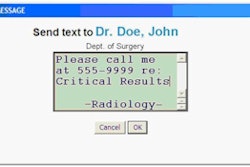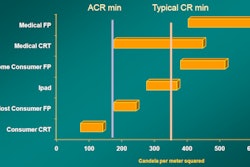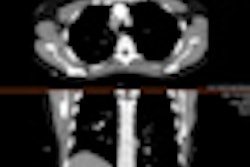BERLIN - Planning for the era of personalized medicine -- a science and an art that combines genetics and patient histories with imaging and population-based atlases -- is finally giving way to real treatment of real patients, according to a presentation on the first day of the Computer Assisted Radiology and Surgery (CARS) meeting.
Chalk up some of the motivation to money. A European Union pledge of 1 billion euros to fund technology projects during the next 10 years has set off a mad scramble in Brussels for grant money, according to CARS Director Heinz Lemke, PhD.
In fact, Lemke's keynote speaker, Dr. Hans Lehrach, director of vertebrate genomics at the Max Planck Institute for Molecular Genetics in Munich, is among the applicants. Lehrach directs the IT Future of Medicine project, whose rather lofty goal is the construction of integrated molecular, physiological, and anatomic modeling systems "for all participants in the healthcare system, from baby to old age," on the basis of multiple "-omics, imaging, and sensor data" -- which includes radiology.
At the core of personalized medicine and Lehrach's project is the idea that with the aid of good analysis and powerful computers, the care of every seriously ill patient will be optimized through the integrated use of well-modeled genomics, imaging, and myriad related technologies that help ensure that targeted treatments are the ones that will do best for the patient.
The CARS organization has joined the process to do its part in developing and integrating computer and radiology-related platforms for personalized patient care.
"It turns out that what we're trying to do is very complementary to what this [CARS] congress is about, trying to individualize medicine," Lehrach said -- something that radiologists scanning patients before surgery "have been doing for a long time." Radiology isn't the only example. "We are just now trying to achieve the same type of individualization which we've had for a long time in anatomy on a molecular basis," he said.
The genome is the basic and most essential source of knowledge about the patient, Lehrach said, and is a highly reliable information source from which to begin planning care. While a computer chip designed by engineers must remain fairly simple, "life by origin had billions of years to optimize its computation process, which is essentially going to look like a neural network -- elements linked to each other and affecting each other," he said. And the concept of a neural network can be applied handily to the integration of knowledge for medical care.
In order for disease care to become more effective and predictable, it must become reproducible in the individual patient. Nowhere will these computation and predictive processes be more critical than cancer treatment, he said, which happens to provide an ideal platform to test the efficacy and cost-effectiveness of personalized care.
The problem
Some 12 million new cancer cases a year -- and very low cure rates that haven't budged in decades -- constitute a huge problem that has withstood expenditures approaching $1 trillion since the declaration of the war on cancer, Lehrach said. And pharmaceutical development costs are only increasing.
"We have a serious problem both individually -- we're all future patients -- and as a society if we cannot predict the result of the computation processes going on inside the organism during a disease, and if we cannot predict which patient will benefit from which treatment."
The problem can only be expected to worsen as the population ages because that's the demographic in which most cancers occur, he said, and in many cases the money spent to fight cancer is being wasted. Colorectal cancer patients with the KRAS genetic mutation, for example, can have access to the best cancer care in the world and yet benefit from no increased survival compared with patients who receive only palliative care, Lehrach said.
In this case, current-generation chemotherapy is not only a tremendous burden on patients, it is a complete waste of money. And it shows how individualized care might become a powerful driver of lower healthcare costs, he said.
"We urgently need techniques that are able to predict which patients are going to benefit from which drug," he said.
New tools
A number of tools are making this job easier, including dramatic improvements in DNA sequencing that can be applied to the patient and the tumor. Basic DNA sequencing, which took more than 10 years to accomplish the first time around, can now be computed in a matter of hours, and soon enough in only minutes and for a very low cost, eventually making genomics available to every patient who walks into the doctor's office, Lehrach said. The Max Planck Institute, the second-largest genome sequencing center in Europe, has been at the forefront of this progress, he said.
"We have mutation models of the genes which are found in the tumors ... and we have the growth factors which govern the behavior of the normal cell, because we want to see how normal cells are affected by each drug," he said. "An unavoidable side effect of any drug is that it will affect the same signaling pathways in all tissues of the body, which it silences as in the tumor unless we use special tricks."
The Hanahan/Weinberg cancer model is dedicated to the reactions of different signaling mechanisms and other effects of treatments in the tumor, he said.
Several other projects under way around the world are dedicated to the advancement of medicine through genomics, Lehrach said. The 1000 Genomes Project is creating a catalog of human polymorphism using next-generation genetic sequencing.
The International Cancer Genome Consortium (ICGC) has Canadians decoding pancreatic cancer, Americans working on glioblastoma and ovarian cancers, Germans attacking pediatric cancer, the French liver and breast cancer, the Chinese examining oral cavity cancers, and so on.
The analytic process is dizzyingly complex, but it has revealed how normal cell function and reaction to therapeutic agents differ from tumors, which are also highly variable but ultimately predictable, Lehrach explained. When the treatment fails, sequencing shows the way to new treatments based on new mutations.
For patients who are sick now, there is the Treat 1000 Cancer Patients project, sponsored by the Max Planck Institute, Charité University in Berlin, and Harvard Medical School in Cambridge, MA. The project is using the results of complex modeling to bring the benefits of genomic medicine to cancer patients.
In one patient with metastatic melanoma, for example, the genome sequencing has revealed many mutations in the protein-coding regions of the affected cells. Transcriptome sequencing of cancer cells has revealed novel genetic mutations. By mapping out the variety of cells and drugs, as well as their effects and side effects, the best combination for the patient can be predicted, he said.
Of course, bringing all this knowledge into clinical practice will require extensive coordination on every level. Lehrach's IT Future of Medicine project -- which has survived its first round of attempts to secure EU funding, he said -- brings academic and industry leaders into the fold under five principal platforms, including:
- Information technology
- Analytic computation
- Medical (including imaging)
- Integration
- Coordination
"If you can combine many different analytic techniques -- proteomics, genomics ... transcriptomics, analysis of metabolites, high-resolution imaging techniques -- we can probably generate systems that will cut the amount of money spent on healthcare," Lehrach said. "It has been estimated that the big countries alone will spend $71 billion on healthcare in the next 10 years. Therefore, if you can move 20% of that into analytic computation for individualized medicine, we can pay for a lot of research leading up to that goal."
Imaging has a key role in the development of personalized medicine, not least by predicting and confirming the molecular makeup of diseased cells, he said.
"A tumor is not a homogeneous mass of cells," Lehrach said. "In addition to consisting of different cell types, it consists of cells with different access to oxygen, which translates into different heat levels, which translates into changes in the molecular biology. So you could very well have a situation in which a drug works on the external parts of a tumor but not the internal parts."
Imaging is key to solving this and many other problems that require the combination of molecular and anatomic data, Lehrach said.
"We don't want the five-dimensional image of the patient but the 50,000-dimensional image of the patient, with each relevant component being one dimension," he said.



















